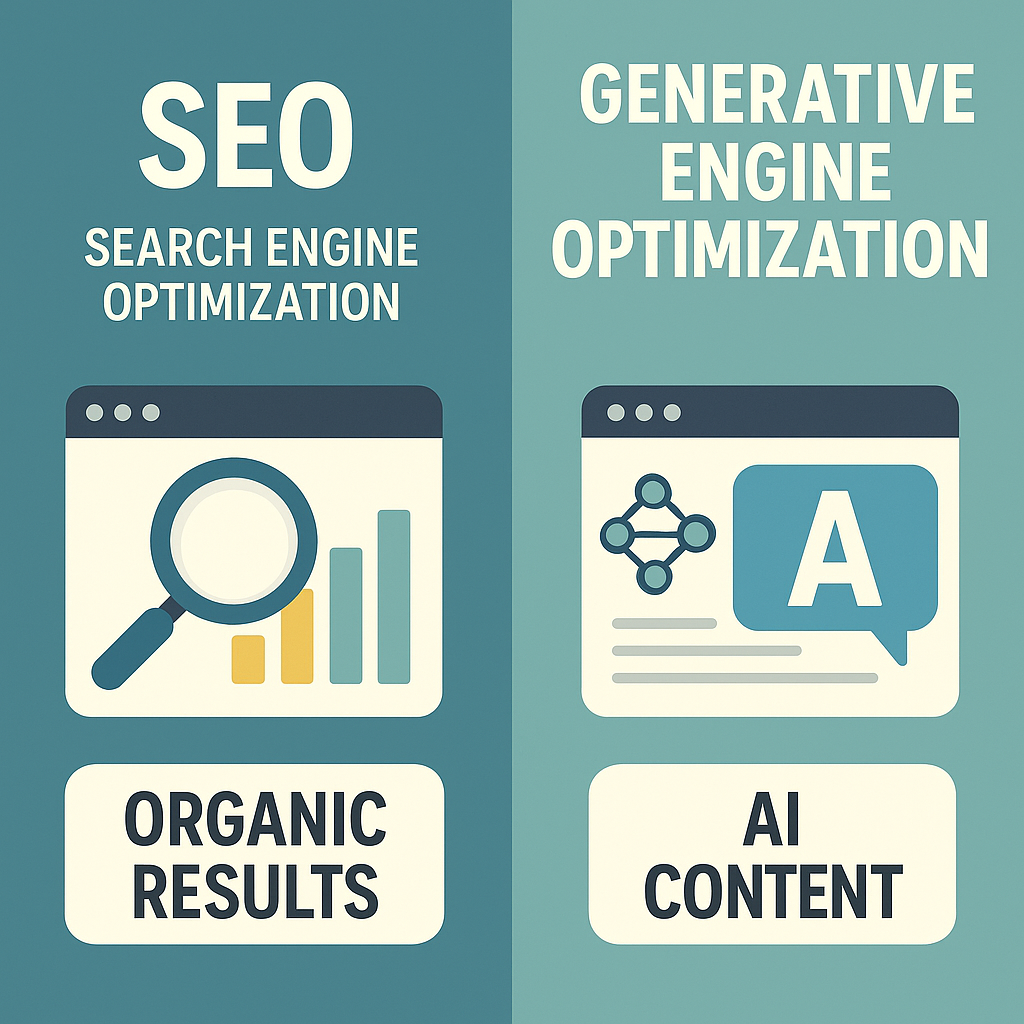10 Key Differences Between Traditional SEO and Generative Engine Optimization
As artificial intelligence transforms the search landscape, marketers face a new challenge: adapting their optimization strategies for AI-driven search engines. While traditional Search Engine Optimization (SEO) remains important, Generative Engine Optimization (GEO) is emerging as a critical discipline for maintaining visibility in an evolving digital ecosystem. This article explores the key differences between these two approaches and how to effectively implement both.
Understanding the Fundamental Shift in Search
Before diving into the differences, it’s essential to understand the paradigm shift occurring in search technology. Traditional search engines return a list of links based on keyword matching and ranking algorithms. In contrast, generative search engines powered by large language models (LLMs) can synthesize information from multiple sources to create direct answers to user queries.
This shift changes not only how users interact with search but also how content creators need to approach optimization. Let’s explore the key differences between traditional SEO and the emerging practice of GEO.
1. Goal: Rankings vs. Source Selection
Traditional SEO
The primary goal of traditional SEO is to achieve high rankings in search engine results pages (SERPs). Success is measured by visibility in these rankings and the resulting click-through traffic to your website.
Generative Engine Optimization (GEO)
GEO focuses on having your content selected as a source for AI-generated answers. Success is measured by how often your content is referenced or cited in AI-generated responses, even when users don’t click through to your site.
2. Content Approach: Keyword-Focused vs. Context-Rich
Traditional SEO
Traditional SEO emphasizes strategic keyword placement, optimized meta tags, and content that matches specific search queries. While quality content is important, the focus often remains on incorporating target keywords at appropriate densities.
Generative Engine Optimization (GEO)
GEO prioritizes context-rich, comprehensive content that demonstrates deep understanding of a topic. Rather than focusing primarily on keywords, GEO emphasizes creating content that thoroughly explains concepts, relationships, and nuances that AI systems can understand and utilize when generating responses.

3. Structure: Page Optimization vs. Information Architecture
Traditional SEO
SEO typically focuses on optimizing individual pages for specific keywords or topics, with emphasis on elements like title tags, meta descriptions, header tags, and URL structure.
Generative Engine Optimization (GEO)
GEO takes a broader view of information architecture, focusing on how concepts are connected and explained across your content. It emphasizes clear hierarchical structure, logical content organization, and explicit relationships between concepts to help AI systems understand the context and relevance of your information.
4. Authority Signals: Backlinks vs. E-E-A-T
Traditional SEO
In traditional SEO, authority is primarily signaled through backlinks from other websites. While other factors matter, the quantity and quality of inbound links remain central to how search engines assess a site’s authority.
Generative Engine Optimization (GEO)
GEO places greater emphasis on Experience, Expertise, Authoritativeness, and Trustworthiness (E-E-A-T) signals within the content itself. This includes clear author credentials, citation of authoritative sources, demonstration of firsthand experience, and content accuracy. While backlinks still matter, the intrinsic signals of authority within your content become more important.
5. User Intent: Query Matching vs. Comprehensive Answers
Traditional SEO
SEO focuses on matching content to specific user queries and intent categories (informational, navigational, transactional). Content is often optimized to directly answer the specific question a user might ask.
Generative Engine Optimization (GEO)
GEO takes a more holistic approach to user intent, aiming to provide comprehensive information that addresses not just the primary question but related questions and context. The goal is to create content that AI systems can draw upon to generate nuanced, complete answers to a variety of related queries.
6. Technical Implementation: HTML Optimization vs. Structured Data
Traditional SEO
Technical SEO focuses on elements like page speed, mobile-friendliness, crawlability, and proper HTML structure to ensure search engines can effectively index content.
Generative Engine Optimization (GEO)
While these technical elements remain important, GEO places greater emphasis on structured data and schema markup to explicitly communicate the meaning and relationships within your content to AI systems. This helps generative engines better understand and utilize your content when creating responses.

7. Content Depth: Targeted vs. Comprehensive
Traditional SEO
SEO often emphasizes creating targeted content that addresses specific queries efficiently. While depth is valuable, there’s often a focus on creating multiple targeted pieces rather than fewer comprehensive resources.
Generative Engine Optimization (GEO)
GEO prioritizes comprehensive, authoritative content that covers topics in depth. Rather than creating multiple thin pieces targeting different keyword variations, GEO favors fewer, more thorough resources that demonstrate complete understanding of a topic and its nuances.
8. Measurement: Traffic vs. Citation
Traditional SEO
SEO success is typically measured through metrics like organic traffic, rankings for target keywords, click-through rates, and conversion metrics tied directly to website visitors.
Generative Engine Optimization (GEO)
GEO requires new measurement approaches that track how often your content is cited or referenced in AI-generated responses. This might include monitoring for attribution in AI answers, tracking brand mentions in generated content, and assessing visibility in AI-driven interfaces.
9. Content Formatting: Skimmable vs. Structured for AI
Traditional SEO
SEO content is often formatted to be easily skimmable by human readers, with bullet points, short paragraphs, and highlighted key points to accommodate shorter attention spans and quick information retrieval.
Generative Engine Optimization (GEO)
While human readability remains important, GEO also considers how AI systems process and understand content. This may include more explicit structure, clearer relationship statements, and content organization that helps AI systems correctly interpret and contextualize information.
10. Competitive Landscape: Ranking Competition vs. Source Authority
Traditional SEO
In traditional SEO, you’re competing for a limited number of ranking positions against other websites targeting the same keywords. The competition is direct and zero-sum—if you rank higher, someone else ranks lower.
Generative Engine Optimization (GEO)
In GEO, the competitive landscape shifts toward establishing your content as an authoritative source that AI systems consistently draw upon. Multiple sources can contribute to a single AI-generated answer, making authority and uniqueness of insight more important than direct ranking competition.
Implementing a Dual Optimization Strategy
Rather than choosing between SEO and GEO, forward-thinking marketers should implement a dual optimization strategy that addresses both traditional search and AI-driven search. Here’s how to approach this:
- Audit Existing Content: Evaluate your content for both SEO fundamentals and GEO principles like comprehensiveness, E-E-A-T signals, and structured information.
- Prioritize Depth and Authority: Focus on creating fewer, more comprehensive resources rather than numerous thin pieces targeting keyword variations.
- Implement Robust Structured Data: Use schema markup to explicitly communicate the meaning and relationships within your content.
- Strengthen E-E-A-T Signals: Clearly establish author expertise, cite authoritative sources, and demonstrate firsthand experience with your subject matter.
- Develop New Measurement Frameworks: Create systems to track both traditional SEO metrics and indicators of content usage in AI-generated responses.
Conclusion: Embracing the Future of Search Optimization
As search technology evolves, so too must our optimization strategies. While traditional SEO remains important for driving direct website traffic, GEO is becoming essential for maintaining visibility in an increasingly AI-driven search landscape.
By understanding the key differences between these approaches and implementing strategies that address both, marketers can ensure their content remains discoverable and valuable regardless of how users interact with search technology.
The future belongs to those who can effectively optimize for both human readers and AI systems, creating content that is comprehensive, authoritative, and structured in ways that both audiences can effectively utilize.
To learn more about implementing effective GEO strategies alongside your existing SEO efforts, explore our comprehensive GEO course designed specifically for marketing professionals.





